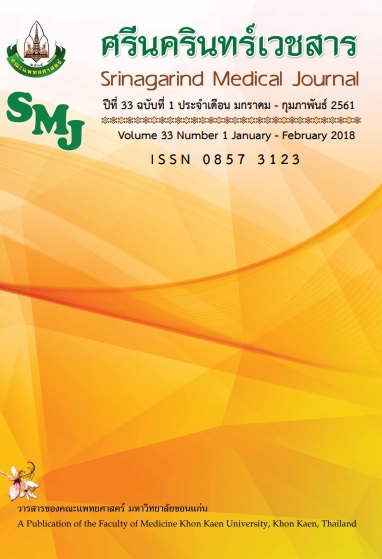Fourier Transform Infrared (FTIR) Spectroscopy of Bile from Cholangiocarcinoma’s Patients and Gall Stone’s Patients
Keywords:
Fourier transform infrared spectroscopy; Bile, Cholangiocarcinoma; Gall stoneAbstract
Background and Objective : Cholangiocarcinoma (CCA) is a cancer of the biliary duct system that commonly invades surrounding liver tissue and extrahepatic bile ducts. It tends to have a poor prognosis at an early stage, high morbidity. Early diagnosis of malignant tumors is very important to prolong the survival of patients. The aim of this study was therefore to determine and analysis of bile spectral profiles obtained by FTIR spectroscopy may differentiate biomarker from patients with CCA and without bile duct malignant strictures.
Methods : This study was approved by the Human Ethics Committee (HE581251). Using FTIR spectroscopy study volunteers bile. The volunteers was performed in two groups of patients. The first group consisted of 30 patients with malignant biliary strictures. The second group consisted of 30 patients without malignant biliary strictures , but diagnostic with gallstone.
Results : The difference spectrum of lipid absorbance bands such as cholesterol, phospholipids, and creatine were higher in the malignant bile sample group than in the gall stone. The spectrum of bilirubin was no difference in the malignant bile sample and in the gall stone.
Conclusions : This work demonstrated the potential of using FTIR spectroscopy as a diagnostic tool for differentiate biomarker from patients bile with CCA and without bile duct malignant strictures.
ฟูเรียร์ทรานฟอร์มอินฟราเรดสเปกโทรสโกปีของน้ำดีจากผู้ป่วยมะเร็งท่อน้ำดีและผู้ป่วยนิ่วในถุงน้ำดี
เพชรากร หาญพานิชย์1* , จิตราภรณ์ วงศ์วิวัฒน์ไชย1 , อนุชา อาฮูยา1, พิศาล ไม้เรียง2 ,
ปนัสดา อวิคุณประเสริญ3 , สุชาติ โกทันย์4 , เอมอร ไม้เรียง1
1ภาควิชารังสีวิทยา คณะแพทยศาสตร์ มหาวิทยาลัยขอนแก่น จ.ขอนแก่น 40002
2ภาควิชาอายุรศาสตร์ คณะแพทยศาสตร์ มหาวิทยาลัยขอนแก่น จ.ขอนแก่น 40002
3ภาควิชาฟิสิกส์ คณะวิทยาศา
หลักการและวัตถุประสงค์ : มะเร็งท่อน้ำดี เป็นมะเร็งที่เกิดจากเซลล์เยื่อบุผิวของท่อน้ำดีที่อยู่ในและนอกตับ จัดเป็นโรคมะเร็งที่มีความรุนแรงสูง มีการพยากรณ์โรคที่ไม่ดี การวินิจฉัยมะเร็งในระยะเริ่มแรกมีความสำคัญต่อการมีชีวิตรอดที่ยาวนานของผู้ป่วย วัตถุประสงค์การศึกษานี้ เพื่อหาและวิเคราะห์น้ำดีด้วยเทคนิค ฟูเรียร์ทรานฟอร์มอินฟราเรดสเปกโทรสโกปี ในการแยกสารบ่งชี้ชีวภาพของผู้ป่วยที่เป็นโรคมะเร็งท่อน้ำดีและไม่เป็นมะเร็งท่อน้ำดี
วิธีการศึกษา : โครงการวิจัยที่ผ่านการรับรองจริยธรรมในมนุษย์ (HE581251) ศึกษาน้ำดีจากอาสาสมัครด้วยฟูเรียร์ทรานฟอร์มอินฟราเรดสเปกโทรสโกปี อาสาสมัคร เป็นผู้ป่วยแบ่งออก 2 กลุ่ม คือ กลุ่มที่ 1 ผู้ป่วยเป็นมะเร็งท่อน้ำดี 30 ราย กลุ่มที่ 2 ผู้ป่วยที่ไม่เป็นมะเร็งท่อน้ำดี แต่วินิจฉัยว่ามีนิ่วในถุงน้ำดี 30 ราย
ผลการศึกษา : สเปกตรัม ช่วงองค์ประกอบของไขมัน คลอเลสเตอรอล ฟอสโฟลิพิด และ ครีเอทีน ผู้ป่วยเป็นนิ่วและผู้ป่วยมะเร็งท่อน้ำดีมีความแตกต่างกัน ส่วนสเปกตรัม ช่วงองค์ประกอบของบิลิรูบิน ผู้ป่วยเป็นนิ่วและผู้ป่วยมะเร็งท่อน้ำดีไม่มีความแตกต่างกัน
สรุป : งานนี้แสดงให้เห็นความสามารถของเทคนิคฟูเรียร์ทรานฟอร์มอินฟราเรดสเปกโทรสโกปี ที่เป็นเครื่องมือในการวินิจฉัยที่แสดงความแตกต่างของสารชีวภาพจากน้ำดีในผู้ป่วยที่เป็นและไม่เป็นมะเร็งท่อน้ำดี
สตร์ มหาวิทยาลัยขอนแก่น จ.ขอนแก่น 40002
4ภาควิชารังสีเทคนิค คณะเทคนิคการแพทย์ มหาวิทยาลัยเชียงใหม่ จ.เชียงใหม่ 50200




